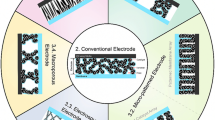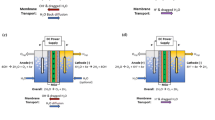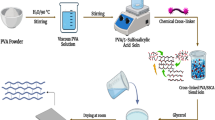Abstract
The solution casting technology was applied to manufacture thin polymer films (~ 20–30 μm) from the ionomer solution of perfluorinated polymer with short side chains (an analogue of the commercial polymer Aquivion®). The influence of annealing temperature on the mechanical properties (elastic limit), proton conductivity, and heat capacity was investigated. The elastic limit, glass transition temperature, and proton conductivity of the samples were found to reach their maximum values at the annealing temperature 170 ± 5 °C. Comparative studies of membrane-electrode assemblies (MEA) using the commercial (Nafion NR212) and solution-casted membranes were carried out. MEA with optimized Aquivion-type membranes showed satisfactory values of fuel crossover and maximum output power. The results of the conducted studies show that the prepared Aquivion-type membranes are very promising for practical application in MEA.







Similar content being viewed by others
References
Dobrovol’skii YA, Volkov EV, Pisareva AV, Fedotov YA, Likhachev DY, Rusanov AL (2007) Proton-exchange membranes for hydrogen-air fuel cells. Russ J Gen Chem 77(4):766–777
Carrette L, Friedrich KA, Stimming U (2001) Fuel cells—fundamentals and applications. Fuel Cells 1(1):5–39
Safronova EY, Yaroslavtsev AB (2016) Prospects of practical application of hybrid membranes. Petroleum Chem 56:281–293
Yaroslavtsev AB, Nikonenko VV (2009) Ion exchange membrane materials: properties, modification and application. Nanotechnologies in Russia 4(3–4):137–159
Nikonenko VV, Yaroslavtsev AB, Pourcelly G (2012) Ionic interactions in natural and synthetic macromolecules. N Jersy: Wiley 267 p
Yaroslavtsev AB, Dobrovolsky YA, Shaglaeva NS, Frolova LA, Gerasimova EV, Sanginov EA (2012) Nanostructured materials for low-temperature fuel cells. Russ Chem Rev 81(3):191–220
Wainright JS, Wang J-T, Weng D, Savinell RF, Litt M (1995) Acid-doped polybenzimidazoles: a new polymer electrolyte. J Electrochem Soc 142(7):L121–L123
Aricò AS, Blasi AD, Brunaccini G, Sergil F, Dispenza G, Andaloro L et al (2010) High temperature operation of a solid polymer electrolyte fuel cell stack based on a new ionomer membrane. Fuel Cell 10(6):1013–1023
Gebert M, Ghielmi A, Merlo L, Corasaniti M, and Arcella V. AQUIVION™—the short-side-chain and low-EW PFSA for next generation PEFCs expands production and utilization. ECS J Solid State Sci Technol 2010;26(1):279–83
Merlo L, Oldani C, Apostolo M, Arcella V (2012) PFSA Aquivion® membranes: general features and degradation mechanisms. Solvay Specialty Polymers SPA
Skulimowska A, Dupont M, Zaton M, Sunde S, Merlo L, Deborah JJ, Rozière J (2014) Proton exchange membrane water electrolysis with short-side-chain Aquivion® membrane and IrO2 anode catalyst. Int J Hydrog Energy 39(12):6307–6316
Boreskov Institute of Catalysis SB RAS, RU Pat, 2545182 C1, 2013
Kulvelis YuV, Ivanchev SS, Lebedev VT, Primachenko VS, Likhomanov VS, Török Gy Structure characterization of perfluorosulfonic short side chainpolymer membranes. Solid RSC Advances, 2015; 5(90): 73820–26
Stassi A, Gatto I, Passalacqua E, Antonucci V, Arico AS, Merlo L, Oldani C, Pagano E (2011) Performance comparison of long and short-side chain perfluorosulfonic membranes for high temperature polymer electrolyte membrane fuel cell operation. J Power Sources 196(21):8925–8930
Park YC, Kakinuma K, Uchida H, Watanebe M, Uchida M (2015) Effects of short-side-chain perfluorosulfonic acid ionomers as binders on the performance of low Pt loading fuel cell cathodes. J Power Sources 275:384–391
Siracusano S, Hodnik N, Jovanovic P, Ruiz- Zepeda F, Šala M, Baglio V et al (2017) New insights into the stability of a high performance nanostructured catalyst for sustainable water electrolysis. Nano Energy 40:618–632
Korchagin OV, Bogdanovskaya VA, Tarasevich MR, Kuzov AV, Zhutaeva GV, Radina MV, Novikov VT, Zharikov VV (2016) Characteristics of nonplatinum cathode catalysts for hydrogen-oxygen fuel cell with proton-conductive and anion-conductive electrolytes. Catalyst in Industry 8(3):265–273
Department of Energy USA. Fuel cell technical team roadmap [Internet]. USA: Department of Energy; 2014 [cited 1 Nov 2017]. Available from: https://energy.gov/sites/prod/files/2014/02/f8/fctt_roadmap_june2013.pdf
D'Urso C, Oldani C, Baglio V, Merlo L, Aric AS (2014) Towards fuel cell membranes with improved lifetime: Aquivion® Perfluorosulfonic Acid membranes containing immobilized radical scavengers. J Power Sources 272:753–758
Luan Y, Zhang Y, Zhang H, Lei L, Li H, Liu Y (2008) Annealing effect of perfluorosulfonated ionomer membranes on proton conductivity and methanol permeability. J Appl Polym Sci 107:396–402
Junsheng L, ** Y, Haolin T, Mu P (2010) Durable and high performance Nafion membrane prepared through high-temperature annealing methodology. J Membr Sci 361:38–42
Lee K, Ishihara A, Mitsushima S, Kamiya N, Ota K (2003) Effect of recast temperature on diffusion and dissolution of oxygen and morphological properties in recast Nafion. ECS J Solid State Sci Technol 151(4):639–645
Liu D, Lai X, Ni J, Peng L, Lana S, Lin Z (2007) Robust design of assembly parameters on membrane electrodeassembly pressure distribution. J Power Sources 172:760–767
Freya Th, Linardi M. Effects of membrane electrode assembly preparation on the polymer electrolyte membrane fuel cell performance. Electrochim Acta 2004;50:99–105
Tong JY, Guo1 Q, Wang XX (2009) Properties and structure of SPEEK proton exchange membrane doped with nanometer CeO2 and treated with high magnetic field. Express Polym Lett 3(12):821–831
Safronova EY, Stenina IA, Yaroslavtsev AB (2017) The possibility of changing the transport properties of ion-exchange membranes by their treatment. Petroleum Chem. 57:299–305
Zhao Z, Hu J, Zhou Z, Zhong M (2007) The use of strong magnetic field treatment for preparation of proton exchange membrane doped by SeO2 and its electrochemical properties. Int J Electrochem Sci 12:5450–5463
Yaroslavtsev AB, Yampolskii YP (2014) Hybrid membranes containing inorganic nanoparticles. Mendeleev Communications 24(6):319–326
Berezina NP, Kononenko NA, Timofeev SV (2002) Effect of conditioning techniques of perfluorinated sulphocationic membranes on their hydrophylic and electrotransport properties. J Membr Sci 209:509–518
Feng K, Tang B and Wu PA. «H2O donating/methanol accepting» platform for preparation of highly selective Nafion-based proton exchange membranes. J Mater Chem A 2015;3:18546–18556
Li HY, Liu YL (2014) Nafion-functionalized electrospun poly(vinylidene fluoride) (PVDF) nanofibers for high performance proton exchange membranes in fuel cells. J Mater Chem A 2:3783–3793
Moore RB, Martin CR (1988) Chemical and morphological properties of solution-cast perfluorosulfonate ionomers. Macromolecules 21:1334–1339
Nicholas WD, Yossef AE (2006) Nafion/poly(vinyl alcohol) blends: effect of composition and annealing temperature on transport properties. J Membr Sci 282:217–224
Hensley E, Douglas W, Steven FD, Kent DA (2007) The effects of thermal annealing on commercial Nafion membranes. J Membr Sci 298:190–201
Osung K, Shijie W, Da-Ming Z (2011) Effect of thermal annealing on proton conduction in ion exchange membranes. Mater Res Soc Symp Pro 1330
Bruno RM, Cleverson AG, Elisabete IS, Muccillo R, Fabio CF (2014) Proton conductivity of perfluorosulfonate ionomers at high temperature and high relative humidity. Appl Phys Lett 104:091904
Acknowledgements
The authors are grateful to Prof. A.B. Yaroslavtsev for fruitful discussion and valuable remarks. The work was fulfilled in the framework of the project No. 17-79-30054 of the Russian Science Foundation.
Author information
Authors and Affiliations
Corresponding author
Ethics declarations
Conflicts of interest
The authors declare that they have no conflict of interest.
Rights and permissions
About this article
Cite this article
Mugtasimova, K.R., Melnikov, A.P., Galitskaya, E.A. et al. Fabrication of Aquivion-type membranes and optimization of their elastic and transport characteristics. Ionics 24, 3897–3903 (2018). https://doi.org/10.1007/s11581-018-2531-5
Received:
Revised:
Accepted:
Published:
Issue Date:
DOI: https://doi.org/10.1007/s11581-018-2531-5




